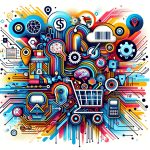
Augmented Reality (AR) is significantly transforming the retail industry by enhancing both online and in-store shopping experiences.
Retailers are leveraging AR to engage customers, increase sales, and create immersive shopping experiences.
Key Implementations and Benefits of AR in Retail:
Enhanced Customer Experience:
AR provides an immersive shopping experience, allowing customers to interact with products in a more personal and engaging way.
For example, Starbucks implemented an in-store AR experience where customers could follow the journey of a coffee bean.
This kind of interactive storytelling not only educates customers but also enhances their overall experience with the brand.
Innovative Product Visualization:
Retailers like IKEA and Warby Parker use AR to allow customers to visualize products in their own space before making a purchase.
This capability helps customers make more informed decisions and reduces the likelihood of product returns.
Virtual Try-Ons and Fitting Rooms:
AR technology enables customers to try on clothing, accessories, and even makeup virtually.
This feature is particularly beneficial for online shopping, as it offers a better understanding of how products look and fit without physically trying them on.
Virtual fitting rooms have been shown to increase customer satisfaction and reduce return rates.
Warehouse Space Optimization and Route Optimization:
AR is not just customer-facing; it also aids in backend operations like warehouse space optimization, helping retailers streamline inventory management.
Additionally, AR can optimize delivery routes, ensuring more efficient and timely deliveries to customers.
vCommerce Experience:
AR is shifting the retail landscape from traditional eCommerce to vCommerce (virtual commerce), which offers a more immersive and interactive digital shopping experience.
Retailers are integrating AR into their websites and apps, allowing customers to experience products in 3D, which significantly enhances the overall shopping experience.
Increased Sales and Customer Engagement:
AR has been shown to increase sales and customer engagement. For instance, implementing AR in stores can increase conversions significantly.
Retailers are using AR-driven marketing strategies and 3D product visualizations to attract and retain customers, thereby increasing revenue and improving return on investment (ROI).
AR is revolutionizing the retail sector by improving customer engagement, enhancing the shopping experience, and optimizing both front-end sales and back-end operations.
Its ability to blend the physical and digital realms is not only attracting more customers but also providing them with a personalized and interactive shopping journey.
As technology continues to evolve, AR is expected to become an even more integral part of the retail experience.
Check out these search results for more details.
Augmented Reality (AR) is being actively implemented in the retail sector, bringing transformative changes to both online and offline shopping experiences.
Here are more detailed insights and examples from various sources:
-
Augmented Reality in Retail: Everything You Need to Know (Shopify):
- Customer Engagement and Sales: Retailers use AR to create immersive shopping experiences that drive engagement and increase sales. For instance, Starbucks’ in-store AR experience allows customers to follow the journey of a coffee bean, enhancing customer education and curiosity.
- Growing Consumer Interest: A significant percentage of consumers express interest in using AR for help in making purchasing decisions. By 2025, a vast majority of the global population and almost all smartphone users are expected to be frequent AR users.
- AR Technology and Functionality: AR works by enhancing the real world with real-time digital content. It uses depth tracking and computer vision to overlay digital content on real-life objects, creating an immersive digital experience.
-
Augmented Reality in Retail: Examples and How to Implement It (Onirix):
- Innovative Examples: Brands like IKEA and Warby Parker offer AR features for visualizing products in customers’ spaces. In the fashion industry, Zara and Nike incorporate AR for interactive experiences, such as virtual testers and gamification games.
- Benefits of AR in Retail: AR helps in providing greater precision at the time of purchase, reducing purchasing decision time, and decreasing the rate of product returns. It also improves the user experience, leading to increased customer engagement and brand loyalty.
-
Augmented Reality in Retail: Use Cases & Business Benefits (Fingent):
- AR in E-commerce and Physical Stores: AR-integrated e-commerce websites and applications on smartphones allow customers to contextually experience products, leading to better conversions. Virtual fitting rooms, placement previews, and interactive packaging are some of the ways AR is used in retail.
- Warehouse Space Optimization and Route Optimization: AR aids in streamlining warehouse management activities and optimizing delivery routes for seamless customer service.
-
Augmented Reality in Retail – vCommerce (Deloitte US):
- vCommerce and WebAR: AR and VR are key to delivering immersive experiences, transforming traditional retail into vCommerce. With the introduction of WebAR, mixed reality is revolutionizing retail, allowing consumers to visualize products in the real world using their mobile devices.
- Omnichannel Experience: Leading retailers are integrating AR to create a seamless omnichannel journey, enhancing the shopping experience across e-commerce and brick-and-mortar stores. Companies like Audi are using AR for product customization and visualization.
-
Augmented Reality in Retail: Key Benefits and Use-Cases (Successive Digital):
- Enhanced Customer Experience: AR allows customers to interact with products and customize them before purchasing. It offers a richer shopping experience compared to traditional online shopping by blending virtual 3D models with the physical world.
- Improved ROI for Retailers: AR can significantly increase conversions and customer engagement, thereby driving revenue and reducing costs associated with product returns and new customer acquisition.
AR is rapidly becoming a crucial tool in retail, offering benefits like enhanced customer engagement, innovative product visualization, improved operational efficiency, and increased sales.
As AR technology continues to evolve, its role in transforming the retail landscape is expected to grow even further.
Unlock Your Potential in Retail Management.
Enroll in our Retail Business Academy Today
Transform Your Career & Business!




















